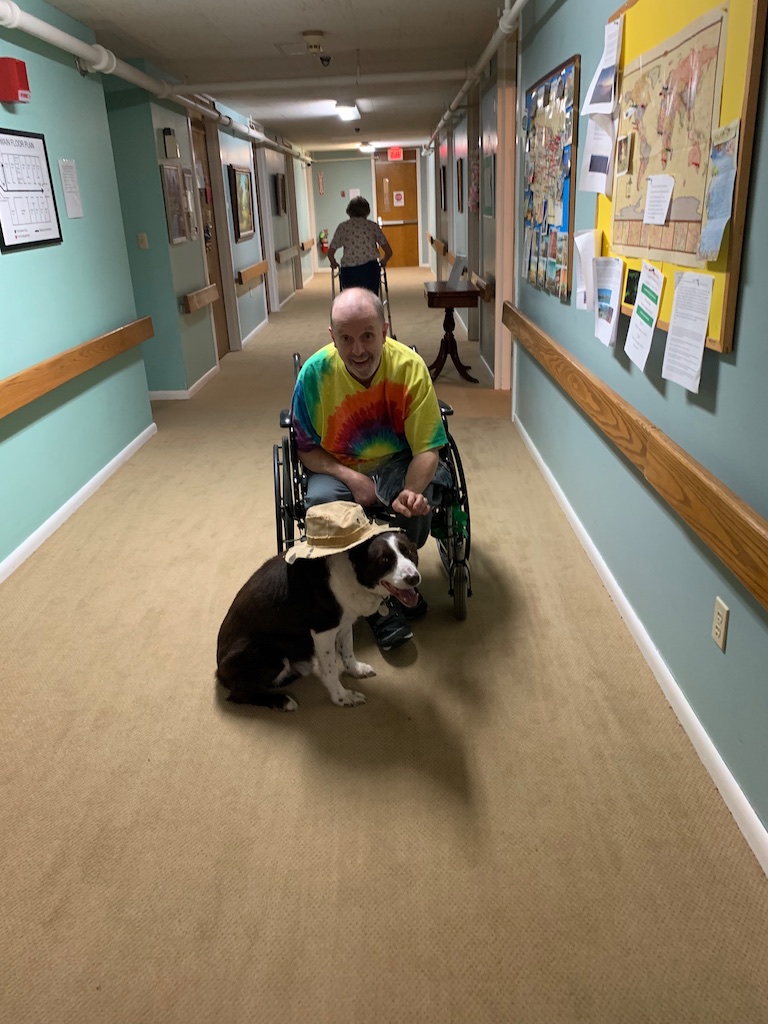People ask me almost every day if I think their dogs could be therapy dogs, and I have to be honest, I can’t say or know without seeing the dog and seeing them work. And even then, trained professionals should make that judgement, not me.
Service dogs and therapy dogs are both valuable, but are also two different things.
The service dog in the context of working with the elderly is mostly about permitting the elderly to touch and/or hug the dog. The dog needs to be obedient and calm but doesn’t always require more training or observation. The people can come to the dog.
The therapy dog – Red is a hospice dog as well as a therapy dog in elder care – needs an additional set of skills. He or she must be agile, able to navigate around wheel chairs and in hospital beds wired with all kinds of monitors and tubes.
He must understand that the skin of the elderly is very thin, and be cut easily by well-meaning paws and claws. He must sometimes get into a narrow hospital bed without touching the patient, or stay calm with hissing and beeping machines and sometimes, screaming and shouting patients in great pain and fear.
A therapy dog must get to people who can’t get to him or her.
A nice dog is great, but it doesn’t necessarily translate into therapy work.
Will the dog be calm around a cat or other animal if he suddenly is faced with one? Can he be trusted absolutely if someone grabs him suddenly, or dresses him up, or grabs him by the ears or tail and hangs on?
Will he stay grounded if an oxygen tank pops or an IV comes out spraying medicine, or he is suddenly sprayed with urine? Can he handle the strong smells of nursing homes and hospitals? The screams of the dying? Can he avoid food even when offered?
Will he absolutely stop when asked, lie down on command, come when called, jump when told, stay when asked, without hesitation or qualification? Because my rule for therapy and hospice work is no mistakes, not one ever. The last thing an elderly or sick or dying person needs is a dog that can’t help them feel good.
One mistake is the last mistake for a therapy dog of mine. When Lenore snatched a patient’s hamburger during a hospice visit, we all laughed. It was her last therapy work.
Red and I have trained together for years now, and I know I can trust him absolutely, he has faced every one of the problems I mentioned, including staying calm when a dementia patient mistook him for a rabid skunk and started beating him with a walker.
Tonight after Bingo, Wayne came up on Red while in his wheelchair, and he took off his hat and put it on Red’s head while his hand was shaking and he had to struggle while Red stayed absolutely still and tolerated the hat.
I realize I never once worried about how he might react, or do the perfectly natural thing of recoiling and running away. Dogs like Red don’t like hats.
I did not train him to be so poised or calm, I wouldn’t know how. I trained him to focus on people and make eye contact with them and to go to people when I pointed at them, and not when I didn’t.
But you can’t train a dog to be Red. That was nature’s gift to therapy work, that was how he came into the world. Karen Thompson was so right. Red was meant to do this work. I trust him completely.
Wayne adores Red, and is lifted up and overjoyed to see him.


My Border collie, Daisy, was like Red. I trained her for a year for that work, but she instinctively knew what
was needed and what to endure. She accomplished some amazing things. Maybe I will write about them in my blog.